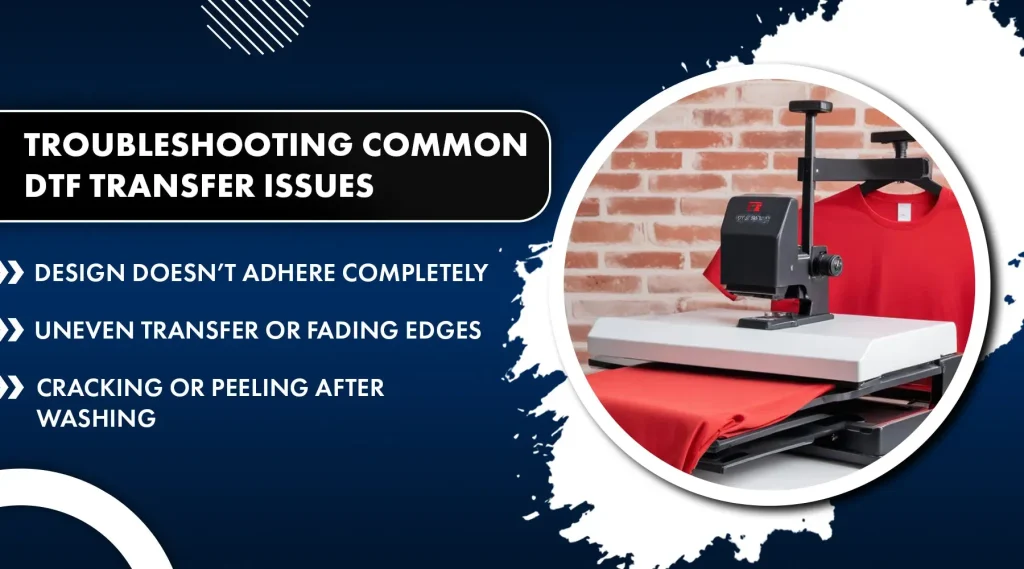DTF transfers troubleshooting is essential for anyone using a direct-to-film workflow, whether you’re printing on cotton, blends, or synthetics, because reliable transfers reduce waste, cut rework, minimize downtime, and improve customer satisfaction. That translates into faster turnarounds, higher profit margins, and more predictable quality across every run. This guide covers the most common issues you’ll encounter in the DTF process, offering practical, field-tested tips and ready-to-apply fixes that align with proven troubleshooting approaches, checklists, and quick reference charts. You’ll learn how to prevent misalignment, poor adhesion, color dulling, and edge cracking, with step-by-step checks you can run in real-world shop conditions across different fabrics. By following targeted calibrations in pre-press, heat-press settings, and post-press care, you can convert fragile transfers into durable, repeatable results that satisfy customers and support your brand image.
Viewed from another angle, these challenges arise within the film-to-garment transfer workflow, where heat, pressure, moisture, and fabric interaction dictate success. In plain terms, this section acts as a practical glossary for direct-to-film decorations, reframing issues as transfer problems, alignment glitches, substrate compatibility, and cure timing to guide fixes. Using Latent Semantic Indexing principles, we connect related concepts such as DTF transfer issues, print reliability, heat press variables, and post-press care to help you diagnose symptoms and select the right parameter adjustments. By focusing on cotton, polyester blends, and synthetics, you build a repeatable process that keeps imagery sharp, colors vibrant, and durability intact through wear and washing.
Frequently Asked Questions
In DTF transfers troubleshooting, what are the most common DTF transfer issues and quick fixes for adhesion and alignment?
Common issues include misalignment, weak adhesion, color problems, and edge lifting. Quick fixes: verify adhesive curing (longer or hotter if the film looks dull); confirm heat press temperature, time, and pressure with manufacturer ranges and adjust in small steps; pre-press the garment 3–5 seconds to remove moisture; ensure correct backing placement with alignment marks and use even pressure; use the right pressing surface (teflon or silicone) and avoid shifting the transfer during application.
From a DTF printing troubleshooting perspective, how can I fix fading or washed-out colors after transfer?
Fading is usually due to improper curing or moisture issues. Fixes: use the correct curing temperature/time for the adhesive; verify print quality and resolution; confirm garment material and pre-treatment compatibility; minimize humidity in the work area; and follow care instructions after washing to preserve color vibrancy.
In DTF transfers troubleshooting, what causes ghosting or halos and how do I fix DTF transfer problems?
Ghosting or halos typically come from misalignment, bleed, or improper print density. Fixes: re-check alignment and ensure the transfer is flat and centered; verify bleed and contour settings and that ink density is appropriate; use a stable platen and avoid garment movement during pressing; confirm transfer film polarity if applicable.
What are some effective DTF heat press tips to improve transfer quality during DTF transfers troubleshooting?
DTF heat press tips: use a stable press with even pressure, set the correct temperature/time for the substrate, and pre-press to remove moisture; avoid moving the garment during pressing; use a protective cover sheet; test settings on a similar fabric and regularly calibrate color management for consistency.
How can I prevent cracking or edge lifting on stretch fabrics in DTF transfer problems during DTF transfers troubleshooting?
Prevent by avoiding over-stretching during handling and considering a longer pre-press for moisture removal; if the adhesive cures too aggressively, reduce press time or temperature; run a small fabric test to dial in settings; ensure even pressure across edges to prevent cracking.
What is a practical DTF heat press tips checklist for reliable results in DTF transfers troubleshooting?
Create a workflow plan per substrate (cotton, blends, synthetics) with reference temps/times/pressures; pre-press consistently; keep the press clean and free of debris; use quality films and powders from reputable suppliers; regularly calibrate printers and color management; log test prints and outcomes for future adjustments; run small tests before large runs; ensure backing removal and use a cover sheet to prevent platen sticking.
| Category | Key Points |
|---|---|
| DTF transfer process overview |
|
| No transfer or incomplete adhesion |
|
| Faded colors after transfer |
|
| Cracking, peeling, or edge lifting on stretch fabrics |
|
| Ghosting, halos, or blurred edges |
|
| Transfer sticking to backing/platen |
|
| White halos or color contamination around edges |
|
| Ink bleed on certain fabrics |
|
| Post-wash peeling or edge lift |
|
| Best practices for reliable DTF transfers troubleshooting |
|
| Practical troubleshooting checklist for common scenarios |
|
| Advanced tips for DTF transfers troubleshooting |
|



